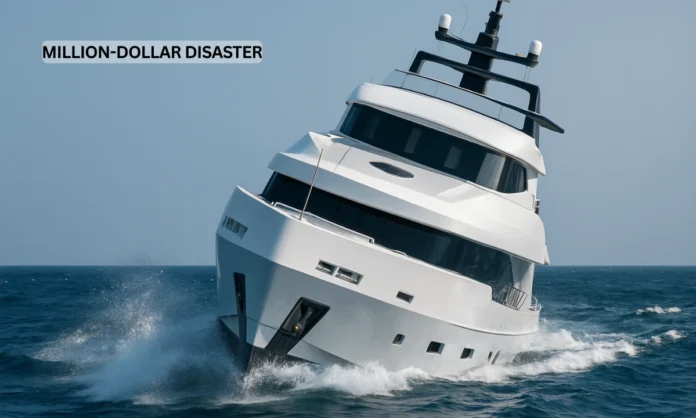Key Highlights:
- The Dolce Vento luxury yacht, valued at nearly $1 million, capsized within 15 minutes of its inaugural launch off Turkey’s Zonguldak coast on September 2, 2025
- All four occupants, including the yacht owner, captain and two crew members, safely evacuated by swimming to shore with no reported injuries
- Construction took place at Med Yilmaz Shipyard over approximately five months, with delivery completed just before the fatal incident
Opening Text
The luxury yacht incident highlights critical safety concerns affecting recreational boating across global waters. On September 2, 2025, the Dolce Vento luxury yacht experienced catastrophic failure just 15 minutes into its maiden voyage off the Turkish coast near Zonguldak, becoming one of the year’s most dramatic yacht failures. The $1 million vessel dramatically listed to port before completely capsizing, forcing all occupants into the Black Sea waters where they successfully swam to safety.
Dramatic Failure During Sea Trial
The Turkish-built luxury yacht experienced immediate stability problems following its launch at approximately 2:30 PM local time on Tuesday afternoon. Video footage captured the vessel being carefully lowered into the water using construction equipment before the dramatic sequence of events unfolded. The 24-meter yacht, valued between $940,000 to $1 million, listed dangerously to its port side within minutes of entering the water.
🚨MADE IN TURKEY
— Harry Theocharous (@TheocharousH) September 3, 2025
A luxury yacht sank just 15 minutes after its maiden launch.
Turkey is launching a fighter jet too, they call it KAAN, claiming it to be better than the F-35 pic.twitter.com/3nmqRDRMpb
- The yacht tipped sharply to one side before vanishing beneath the waves
- Construction equipment was used to ease the vessel into the water during launch
- Dramatic video footage captured the entire sequence from launch to capsizing
- The incident occurred approximately 200 meters from shore in the Black Sea
Emergency responders from the Turkish Coast Guard quickly cordoned off the affected area and initiated recovery operations. All four individuals aboard the luxury yacht successfully abandoned ship and swam the short distance to shore without requiring medical attention. The swift response prevented any casualties, though the vessel was declared a total loss.edition.
Construction and Technical Specifications
The Dolce Vento was built at Med Yilmaz Shipyard in Eregli, Turkey, with construction beginning in 2024 and completed just months before the incident. The motor yacht featured a steel hull construction with aluminum superstructure, measuring 24 meters in length with a gross tonnage of 160 GT. Construction took approximately five months to complete before delivery to its Istanbul-based owner.
- Steel hull and aluminum superstructure construction
- 24-meter length with 160 GT internal volume
- Construction period spanned five months in 2024
- Built at Med Yilmaz Shipyard facility in Eregli, Turkey
The shipyard confirmed that technical inspections and formal investigations have commenced to determine the exact cause of the catastrophic failure. Maritime experts suggest that stability issues, particularly miscalculated metacentric height, may have contributed to the rapid sinking. The metacentric height represents a crucial naval architecture measurement affecting vessel balance and stability during operation.
Investigation and Safety Implications
Turkish maritime authorities launched comprehensive investigations into the luxury yacht incident, with preliminary theories focusing on fundamental design and stability problems. The incident raises broader concerns about yacht construction standards and safety protocols during maiden voyages. Maritime safety experts emphasize that proper stability calculations and sea trials are essential before vessel delivery to owners.
- Formal technical inspections initiated by Turkish authorities
- Preliminary focus on stability issues and metacentric height calculations
- Recovery operations conducted by Turkish Coast Guard personnel
- Investigation findings expected to influence future yacht construction standards
According to U.S. Coast Guard recreational boating statistics, the 2023 reporting year recorded 3,844 accidents involving 564 deaths, 2,126 injuries, and approximately $63 million in property damage across American waters. The fatality rate stood at 4.9 deaths per 100,000 registered recreational vessels, representing a 9.3% decrease from the previous year. These statistics demonstrate the inherent risks associated with recreational boating activities worldwide.

Key Recreational Boating Accident Statistics in the US (2023)
Economic Impact and Tourism Context
Zonguldak serves as a significant tourist destination along Turkey’s Black Sea coast, attracting thousands of visitors annually to attractions like Gökgöl Cave, which recorded 60,506 visitors in 2024. The region combines industrial heritage with natural beauty, making it popular among domestic and international tourists. The luxury yacht incident occurred in waters frequented by recreational boaters and tourists exploring the coastal region.
- Zonguldak attracted over 60,000 visitors to major attractions in 2024
- Region combines industrial history with Black Sea coastal tourism
- Popular destination for recreational boating and water activities
- Tourism infrastructure supports both domestic and international visitors
The total loss of the luxury yacht represents significant financial impact for both the owner and the shipyard. Maritime insurance typically covers such incidents, though the dramatic nature of this particular failure during the maiden voyage may complicate claims processing. The incident also affects the reputation of Med Yilmaz Shipyard, potentially impacting future business prospects and client confidence in their construction capabilities.
This incident demonstrates the critical importance of thorough testing and quality assurance in luxury yacht construction. The dramatic failure within minutes of launch suggests fundamental design or construction flaws that proper sea trials should have identified before delivery. Maritime safety regulations and industry standards continue evolving to prevent such catastrophic failures and protect both vessel occupants and surrounding marine traffic from similar incidents.


